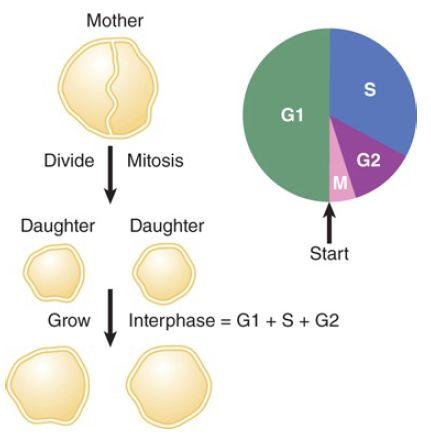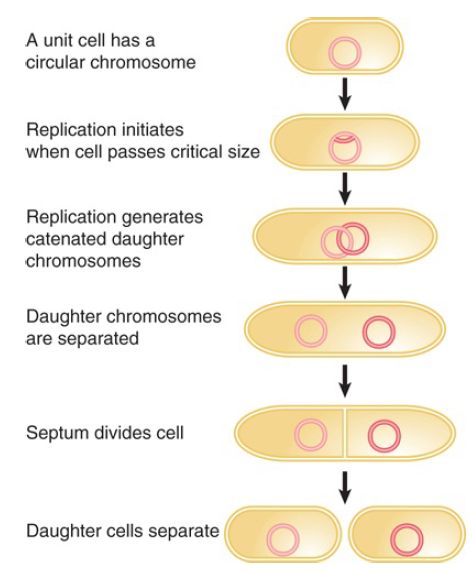
Introduction to the Replication Is Connected to the Cell Cycle
 المؤلف:
JOCELYN E. KREBS, ELLIOTT S. GOLDSTEIN and STEPHEN T. KILPATRICK
المؤلف:
JOCELYN E. KREBS, ELLIOTT S. GOLDSTEIN and STEPHEN T. KILPATRICK
 المصدر:
LEWIN’S GENES XII
المصدر:
LEWIN’S GENES XII
 الجزء والصفحة:
الجزء والصفحة:
 30-3-2021
30-3-2021
 2757
2757
Introduction to the Replication Is Connected to the Cell Cycle
A major difference between prokaryotes and eukaryotes is the way in which replication is controlled and linked to the cell cycle. In eukaryotes, the following are true:
-Chromosomes reside in the nucleus.
-Each chromosome consists of many units of replication called replicons.
-Replication requires coordination of these replicons to reproduce DNA during a discrete period of the cell cycle.
-The decision about whether to replicate is determined by a complex pathway that regulates the cell cycle.
-Duplicated chromosomes are segregated to daughter cells during mitosis by means of a special apparatus.
In eukaryotic cells, replication of DNA is confined to the second part of the cell cycle called S phase, which follows G1 phase (see FIGURE 1). The eukaryotic cell cycle is composed of alternating rounds of growth followed by DNA replication and then cell division.
After the cell divides into two daughter cells, each has the option to continue dividing or stop and enter G0. If the decision is to continue to divide, the cell must grow back to the size of the original parent cell before division can occur again.

FIGURE .1 A growing cell alternates between cell division of a mother cell into two daughter cells and growth back to the original size.
The G1 phase of the cell cycle is concerned primarily with growth (although G1 is an abbreviation for first gap because the early cytologists could not see any activity). In G1 everything except DNA begins to be doubled: RNA, protein, lipids, and carbohydrates.
The progression from G1 into S is very tightly regulated and is controlled by a checkpoint. For a cell to be allowed to progress into S phase, there must be a certain minimum amount of growth that is biochemically monitored. In addition, there must not be any damage to the DNA. Damaged DNA or too little growth prevents the cell from progressing into S phase. When S phase is complete, G2 phase commences; there is no control point and no sharp demarcation.
The start of S phase is signaled by the activation of the first replicon—usually in euchromatin—in areas of active genes. Over the next few hours, initiation events occur at other replicons in an ordered manner.
However, replication in bacteria, as shown in FIGURE .2, is triggered at a single origin when the cell mass increases past a threshold level, and the segregation of the daughter chromosomes
is accomplished by ensuring that they find themselves on opposite sides of the septum that grows to divide the bacterium into two.

FIGURE .2 Replication initiates at the bacterial origin when a cell passes a critical threshold of size. Completion of replication produces daughter chromosomes that might be linked by recombination or that might be catenated. They are separated and moved to opposite sides of the septum before the bacterium is divided into two.
How does the cell know when to initiate the replication cycle? The initiation event occurs once in each cell cycle and at the same time in every cell cycle. How is this timing set? An initiator protein could be synthesized continuously throughout the cell cycle; accumulation of a critical amount would trigger initiation. This is consistent with the fact that protein synthesis is needed for the initiation event.
Another possibility is that an inhibitor protein might be synthesized or activated at a fixed point and then diluted below an effective level by the increase in cell volume. Current models suggest that variations of both possibilities operate to turn initiation on and then off precisely in each cell cycle. Synthesis of active DnaA protein, the bacterial initiator protein, reaches a threshold that turns on initiation, and the activity of inhibitors turns subsequent initiations off for the rest of the cell cycle.
Bacterial chromosomes are specifically compacted and arranged inside the cell, and this organization is important for proper segregation, or partition, of daughter chromosomes at cell division.
Some of the events in partitioning the daughter chromosomes are consequences of the circularity of the bacterial chromosome. Circular chromosomes are said to be catenated when one passes through another, connecting them. Catenation is a consequence of incomplete removal of topological links during DNA replication, and topoisomerases are required to remove these links and separate the chromosomes. An alternative type of structure is formed when a recombination event occurs: A single recombination between two monomers converts them into a single dimer. This is resolved by a specialized recombination system that recreates the independent monomers.
The key goals in the chapters that follow are to define the DNA sequences that function in replication and to determine how they are recognized by appropriate proteins of the replication
apparatus. In subsequent chapters, we examine the unit of replication and how that unit is regulated to start replication; the biochemistry and mechanism of DNA synthesis; and autonomously replicating units in bacteria, mitochondria, and chloroplasts.
 الاكثر قراءة في مواضيع عامة في الاحياء الجزيئي
الاكثر قراءة في مواضيع عامة في الاحياء الجزيئي
 اخر الاخبار
اخر الاخبار
اخبار العتبة العباسية المقدسة


